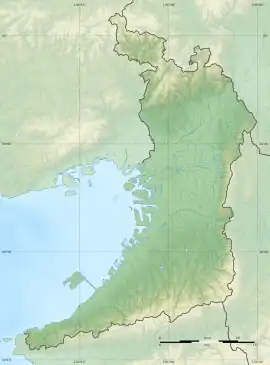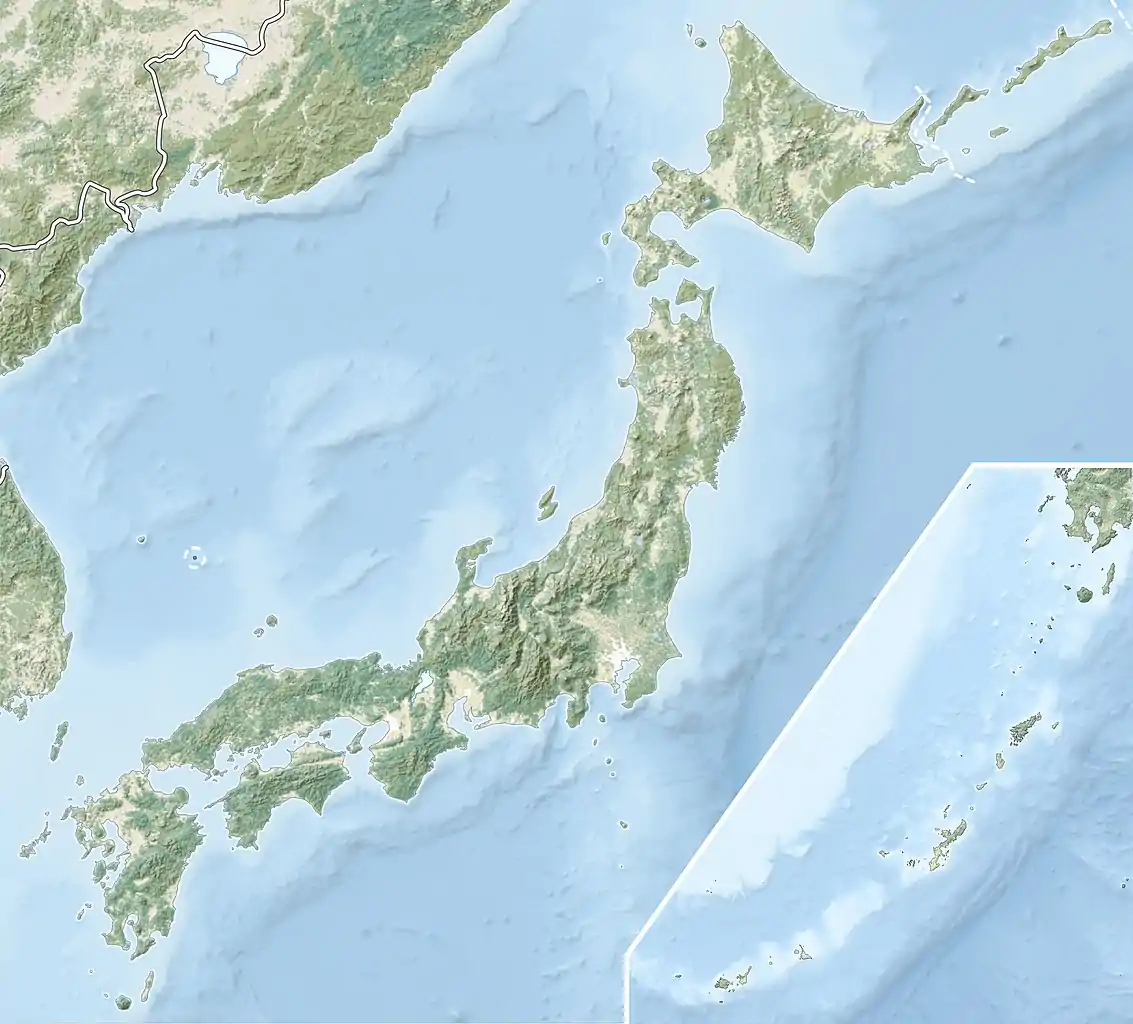| Tannan Domain 丹南藩 | |
|---|---|
| under Tokugawa shogunate Japan | |
| 1623–1871 | |
| Capital | Tannan jin'ya |
| Area | |
| • Coordinates | 34°33′33.7″N 135°33′23.0″E / 34.559361°N 135.556389°E |
| • Type | Daimyō |
| Historical era | Edo period |
• Established | 1623 |
• Disestablished | 1871 |
| Today part of | part of Osaka Prefecture |


Tannan Domain (丹南藩, Tannan-han) was a feudal domain under the Tokugawa shogunate of Edo period Japan, located in Kawachi Province in what is now the southeastern portion of modern-day Osaka Prefecture. It was centered around Tannan jin'ya in what is now the city of Matsubara and was controlled by the fudai daimyō Takagi clan all of its history.[1][2][3]
History
Takagi Masatsugu was the son of Takagi Kiyohide, one of Tokugawa Ieyasu's 16 Generals. With holdings of 9000 koku scattered across Sagami, Musashi, Kazusa, Shimōsa, and Ōmi Province, he was ranked as a hatamoto. In 1623, he was appointed to the post of Osaka jōban (大坂定番), a minor post which was responsible for guarding the Kyōbashiguchi and Tamazoguchi gates of Osaka Castle for which he received an additional 1000 koku in revenue. This placed his kokudaka over the 10,000 koku mark requited to qualify as a daimyō, and his holdings were consolidated to 22 village in Kawachi Province,where he constructed a jin'ya.
His son, Takagi Masanari acquired an additional 3000 koku in Kazusa and Awa Provinces, but the 3rd daimyō, Takagi Masahiro distributed 1500 koku each to his two younger brothers. During the tenure of the 6th daimyō, Takagi Masanobu,the domain received an exemption from the sankin kōtai requirement to travel to Edo on alternative years to attend the Shogun's court. Instead, the daimyō of the domain resided permanently in Edo, and managed the domain's affairs though a daikan and other officials. In 1769, under the 8th daimyō, Takagi Masanori, a widespread peasant's revolt occurred in the domain which resulted in22 village headmen being summoned to the domain's Edo residence. As a result, the Shogunate blamed Masanori for mismanagement and banned him from entering Edo Castle. During the Bakumatsu period, the 12th daimyō, Takagi Masahiro was ordered to dispatch troops in 1866 to suppress a revolt which had arisen in tenryō territory in what is now Kashiwara. The clan's finances, which had been in arrears since the mid-Edo period were close to collapse, with debts exceeding 39,000 ryō. In 1868,the han school, "Tannan Gakkō" was opened. The final daimyō, Takagi Masayoshi, served as imperial governor until the abolition of the han system in 1871. He was ennobled with the kazoku peerage title of viscount (shishaku) in 1884.
The site of the jin'ya became a field of private land in 1921 and there now no trace left. An archaeological excavation in 1999 confirmed the foundations of the jin'ya and the han school.
Holdings at the end of the Edo period
As with most domains in the han system, Tannan Domain consisted of several discontinuous territories calculated to provide the assigned kokudaka, based on periodic cadastral surveys and projected agricultural yields.[4][5]
- Kawachi Province
- 2 villages in Shiki District
- 12 villages in Tannan District
- 6 villages in Tanboku District
- Shimotsuke Province
- 4 villages in Ashikaga District
List of daimyō
# Name Tenure Courtesy title Court Rank kokudaka  Takagi clan, 1623-1871 (fudai)
Takagi clan, 1623-1871 (fudai)1 Takagi Masatsugu (高木正次) 1623 - 1631 Mondo-no-sho (主水正) Junior 5th Rank, Lower Grade (従五位下) 10,000 koku 2 Takagi Masanari (高木正成) 1631 - 1635 Mondo-no-sho (主水正) Junior 5th Rank, Lower Grade (従五位下) 10,000 koku 3 Takagi Masahiro (高木正弘) 1635 - 1658 Mondo-no-sho (主水正) Junior 5th Rank, Lower Grade (従五位下) 10,000 koku 4 Takagi Masamori (高木正盛) 1658 - 1670 Mondo-no-sho (主水正) Junior 5th Rank, Lower Grade (従五位下) 10,000 koku 5 Takagi Masatoyo (高木正豊) 1670 - 1681 Buzen-no-kami (肥前守) Junior 5th Rank, Lower Grade (従五位下) 10,000 koku 6 Takagi Masanobu (高木正陳) 1681 - 1741 Mondo-no-sho (主水正) Junior 5th Rank, Lower Grade (従五位下) 10,000 koku 7 Takagi Masatsune (高木正恒) 1741 - 1743 Wakasa-no-kami (若狭守) Junior 5th Rank, Lower Grade (従五位下) 10,000 koku 8 Takagi Masanori (高木正弼) 1743 - 1780 Mondo-no-sho (主水正) Junior 5th Rank, Lower Grade (従五位下) 10,000 koku 9 Takagi Masanao (高木正直) 1780 - 1781 Mondo-no-sho (主水正) Junior 5th Rank, Lower Grade (従五位下) 10,000 koku 10 Takagi Masakata (高木正剛) 1781 - 1826 Mondo-no-sho (主水正) Junior 5th Rank, Lower Grade (従五位下) 10,000 koku 11 Takagi Masaakira (高木正明) 1826 - 1848 Mondo-no-sho (主水正) Junior 5th Rank, Lower Grade (従五位下) 10,000 koku 12 Takagi Masahira (高木正坦) 1848 - 1869 Mondo-no-sho (主水正) Junior 5th Rank, Lower Grade (従五位下) 10,000 koku 13 Takagi Masayoshi (高木正善) 1869 - 1871 Buzen-no-kami (肥前守) Junior 5th Rank, Lower Grade (従五位下) 10,000 koku
See also
Further reading
- Bolitho, Harold. (1974). Treasures Among Men: The Fudai Daimyo in Tokugawa Japan. New Haven: Yale University Press. ISBN 978-0-300-01655-0; OCLC 185685588
References
- ↑ Nakayama, Yoshiaki (2015). 江戸三百藩大全 全藩藩主変遷表付. Kosaido Publishing. ISBN 978-4331802946.(in Japanese)
- ↑ Nigi, Kenichi (2004). 藩と城下町の事典―国別. Tokyodo Printing. ISBN 978-4490106510.
- ↑ Papinot, E (1910). Historical and Geographic Dictionary of Japan. Tuttle (reprint) 1972.
- ↑ Mass, Jeffrey P. and William B. Hauser. (1987). The Bakufu in Japanese History, p. 150.
- ↑ Elison, George and Bardwell L. Smith (1987). Warlords, Artists, & Commoners: Japan in the Sixteenth Century, p. 18.